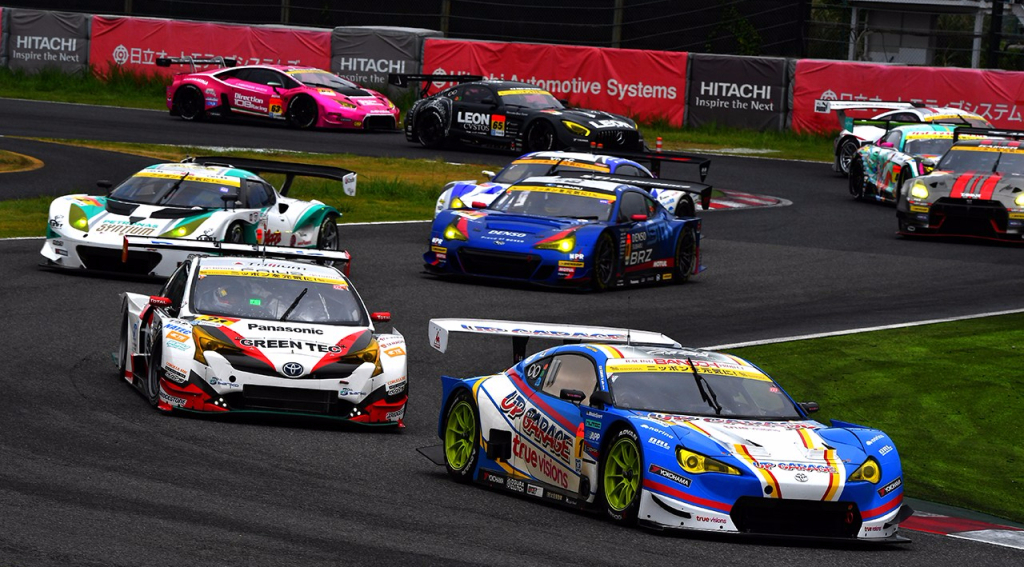Next year, the summer endurance race at Suzuka Circuit that is now known as the International Suzuka 1000km will change significantly. The race will grow from a 1000 kilometer enduro, to a 10-hour enduro. Most significantly of all, the GT500 class will no longer take part.
From 2018 onward, the FIA GT3 and JAF-GT300 classes will take centre stage at the new Suzuka 10 Hours. In theory, the new race for next year and beyond will pit the top GT300 teams from Super GT, versus the top GT3 teams from Super Taikyu, Blancpain GT, IMSA’s GT Daytona class, and beyond.
And in theory, that would mean that whichever team wins the GT300 class in this, the 46th and final Suzuka 1000km, will go on to enter the inaugural Suzuka 10 Hours as its defending champion, in a sense. Throw in a heated championship battle contested among the largest, most competitive GT300 championship field in history, and it’s no wonder why Super GT’s second division is poised to steal the show in this weekend’s final chapter of Japan’s great race.
The full field of 30 cars and teams will take part, bringing with them a total of 71 drivers – with eleven teams bringing three-driver squads to the race. 17 of those drivers have won the GT300 class at the Suzuka 1000km before, and four are former overall winners from years past.
Suzuka’s abundance of high-speed corners will, on paper, favour the JAF-GT300 and Mother Chassis vehicles, which have combined to take pole position in five of the last five years, since the start of the FIA + JAF era in 2012. However, in terms of race winners, it’s 3-2 in favour of the FIA GT3 cars in that same time frame. That’s not all too surprising: With this being the longest race on the calendar, it’s not always the fastest car that wins the race.
Subaru and R&D Sport have collaborated to create a mini-dynasty in the GT300 class at this fabled race. Winners in 2010 and 2011 with the previous Legacy B4, and in 2013 with the BRZ, they added their fourth win in the last seven years last year, thanks to a brilliant race dictated by pace and perfect strategic execution from the Blue Boxers.
Once again, the #61 Subaru BRZ R&D Sport of Takuto Iguchi and Hideki Yamauchi will be looked upon as the favourites to win a fifth time in the last eight years. The car is certainly capable, their duo of young drivers are among the best in the field, and, if the weather at Suzuka becomes as volatile as it has in the last two years running, their Dunlop tyres – one of four cars supplied by Dunlop – will certainly be up to the task.
Carrying an additional 50 kilograms of additional Success Ballast isn’t ideal for the Subaru BRZ, but in GT300, there are better chances of overcoming it: Twice since 2009, the race has been won by a car with more than 50 kilos on board – 66kg in 2009, and a whopping 88kg in 2015. And of course, with an additional five championship points on offer to the winning team and drivers, another 1000 victory for Iguchi and Yamauchi would put them right up at the head of that championship fight for the final two rounds of the season.
But the Toyota Prius apr GT has also performed well at Suzuka, taking two runner-up finishes in the last three years. This year, it’s another dual Prius attack on the field, and following their first podium finish of 2017, the #31 Prius of 2006 winner Koki Saga and sophomore Rintaro Kubo will lead the charge for apr Racing – the most accomplished GT300 team that has never won this race.
The sister #30 Prius of Hiroaki Nagai & Kota Sasaki is a longer shot to win as a pro-am team, but the experience of Sasaki – one of three former three-time GT300 winners in this year’s field – can’t be understated.
Then there’s the six Mother Chassis cars, of which two have performed brilliantly in this race in the last two years – but without taking the ultimate prize. Last year it was the #18 Upgarage Bandoh Toyota 86 MC (Yuhki Nakayama/Shintaro Kawabata). The year before, it was the #2 Syntium Apple Lotus Evora MC (Kazuho Takahashi/Hiroki Katoh/Hiroshi Hamaguchi). Last year, Katoh and rookie sensation Tadasuke Makino looked set to steal the whole show for Lotus, but a crash ended their day halfway through.
The MCs are genuinely quick at Suzuka, and project to be quick once again. Just on the sheer driving talents of Takamitsu Matsui, Kenta Yamashita, and Tsubasa Kondo, even the #25 VivaC 86 MC – on +82kg of Success Ballast – could be a factor.
There are two upset-minded dark horses out of this camp that might be worth looking out for as well: The #5 Mach Syaken 86 MC (Natsu Sakaguchi/Kiyoto Fujinami/Tetsuji Tamanaka) is deceptively fast, and will be out to win it in team director Tamanaka’s final race as a driver. Meanwhile, the #52 Saitama Toyopet GreenBrave Mark X MC loaded up on experience, signing former GT300 class winner Shogo Mitsuyama to partner two-time overall winner Shigekazu Wakisaka and Taku Bamba.
Back to the FIA GT3 cars, and the championship leaders, Nobuteru Taniguchi and Tatsuya Kataoka, pilots of the #4 Goodsmile Hatsune Miku Mercedes-AMG GT3 that leads the tables by nine points over Matsui & Yamashita in the VivaC 86.
The early season successes, however, mean that the Miku AMG will carry the maximum 100 kilograms of Success Ballast into the Suzuka 1000km. As proven before, high ballast isn’t always a death knell. But it will make for a very difficult weekend for Goodsmile Racing with Team UKYO, where their priority will simply be a solid points-scoring result in the pursuit of a third GT300 championship for GSR, NOB & TK.
In the GT3 contingent are the other two former three-time class winners, going for four in 2017: The #3 B-Max NDDP Nissan GT-R of Kazuki Hoshino & Mitsunori Takaboshi, and the #60 Syntium LM Corsa Lexus RC F GT3, of Hiroki Yoshimoto & Akira Iida.
Hoshino, who was also an overall winner in 2006, is joined by Takaboshi, who impressed many on his GT500 debut at this race a year ago. Together, after a lackluster start to 2017, they’re out to win the race for their legendary team director, Masahiro Hasemi – who never won the race as a driver, and who has yet to win the race as a team boss. In the case of Yoshimoto, he’s looking for his fourth win with as many different manufacturers – Mooncraft, Aston Martin, and most recently BMW in 2014.
Both Japanese GT3 cars are quick, and capable of competing for the win this time out. Neither car has more than 26 kilograms of success ballast.
While it’s Autobacs Racing Team Aguri’s #55 BMW M6 GT3 (Shinichi Takagi/Sean Walkinshaw) that captured the headlines with a hat trick of victories at the Fuji 300km, it’s BMW Team Studie, and the #7 Studie BMW M6 that have a great chance of winning this time out at Suzuka. They were third in 2014, second in 2015, and had aspirations of winning last year until suffering the indignity of a terminal mechanical failure before the race even started.
Augusto Farfus will once again join Jörg Müller and Seiji Ara aboard the Studie BMW. He’s one of two notable international third drivers for this race. The other is former F1 star Christian Klien, who joins the young duo of Shinnosuke Yamada & Jake Parsons in the #26 Taisan SARD Audi R8 Fukushima – hoping to win it for Audi, one of a handful of GT3 manufacturers who haven’t won this class.
Truth be told, there’s many worthy contenders for the Suzuka 1000km victory in GT300. For instance, the #65 Leon Cvstos AMG (Haruki Kurosawa/Naoya Gamou) has been the fastest car in the last two races in a row, and their speed can’t be ignored on Bridgestone tyres – which, oddly enough, haven’t won the Suzuka 1000km before in GT300.
There’s also the returning Sven Müller, back in the #33 D’station Porsche 911 GT3-R with Tomonobu Fujii after missing the last three rounds. Look for the German rookie to make an immediate impact in the cockpit of the D’station Porsche, who along with the #9 Gulf NAC Porsche 911 (Jono Lester/Kyosuke Mineo), have as good a chance as any representing the Porsche badge.
That said, anything can happen over the span of 1,000 grueling kilometers – and there’s countless other teams not mentioned that could be up for a shock top-ten finish, a podium, or even a victory. An underdog team could rise off the canvas and into the front of the field, just by simply going the distance.
But out of this ultra-competitive 30-car grid, there can be only one GT300 class winner of the 2017 Suzuka 1000km – and the bragging rights to be called the defending champion going into the 2018 Suzuka 10 Hours.






